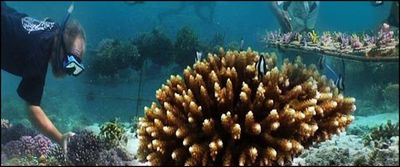In some parts of the world, corals are being as well looked after as your front lawn. But before you should rush out with the lawnmower, a little training might help. By Jeremy Torr.
Fiji, 13 April 2011. Corals in many parts of the world are undergoing immense environmental stresses, such as rising water temperatures and pollution, that affect their health and growth. Thanks to many small groups of enthusiastic divers in the Pacific, some coral reefs are springing back to life.
New corals equal new fish life
Fiji, one of the small island groups in the middle of the Pacific, is a place where active divers are making a difference. The Coral Farming program started in Fiji under the name “The Coral Gardens-Living Reefs Initiative” and since its inception over a decade ago has been extended to other island chains in the Pacific, as well as the Caribbean.
While simple techniques are used, coral farming and coral gardening both require specialist training - corals are quite sensitive and are also quite easy to kill. Founding agents PCDF (Partners in Community Development Fiji) and all other participating bodies in the Corals for Conservation gardening scheme are well aware of potential risks posed to the coral reef system. They caution casual divers against trying to replicate their methods without proper training and without the proper permission obtained from government authorities.
Coral Green Fingers
Mother corals are first established in coral farms by trimming sections off wild corals. Where possible, entire colonies are selected from populations of jeopardised corals, such as where the corals are growing so close together that competition for space results in corals dying, or where corals are exposed out of the water at low tide. Another source of mother corals comes from corals broken off and left on the ocean floor by fishing activities, anchors, and storm waves.
After growing the mother corals for about two years, the corals reach the size of a large dinner plate. At that point, they are trimmed to produce lots of 2-5cm “seed corals”, which are in turn planted onto 4cm concrete disks or “coral cookies”. Each coral cookie is shaped like a button, with two small holes for threading fishing line through. These cookies are then woven onto heavy metal frames with sturdy lines, and placed on underwater tables made of iron bars.
The corals are left to grow in the coral farms for 6 to 14 months and if all goes well grow rapidly into second-generation corals. These are then either replanted into natural sites identified for restoration, or onto coral castles.

Corals are farmed, then harvested to grow more corals, and then transplanted to a manmade structure.
The coral castles or houses are usually placed in areas of reef with poor habitat for fish; that is, they are low in coral numbers and have fewer hiding places. So the coral gardeners make little fish houses and castles out of stone and cement. These hollow structures also become coral protectors and breeding grounds for local fish shoals.
Coral Trade
Not all of the corals grown end up under the water. Some are harvested, bleached and coloured with acrylic paints to re-establish a more realistic coral colour, then sold as tourist gifts to raise money for local communities through the “Buy a Coral, Save a Reef” program.

Although coral trade is discouraged as it encourage poaching from the wild, proper management of community-based coral harvest program is a means of raising funds to help the poor.
The basic rule for the gardeners is always to engage people in a hands-on activity that gives something permanent back to the reef. As such, the program trains community members and holiday resort staff to actively care for the corals on their reefs. Just like on land, highly used gardens need maintenance. So the underwater gardens also need pest infestations controlling, damaging weeds removing, and rubbish removing.
The Corals for Conservation gardeners work with fishing communities and the tourism industry to conserve the coral reefs that they all depend upon. Conservation areas and marine parks are established and these areas in turn work to restore the coral reef balance, becoming nursery areas for fish and other animals, which then spill over to the fishing grounds.
More fish and healthier corals lead to prosperous communities and enhanced tourism. As the teams and volunteers work to restore reef areas, people become closely connected with the reef and better able to understand and protect it.
Corals for Conservation Volunteers
Thanks to lots of keen Corals for Conservation volunteers who posted hundreds of images and video of their work, the project has come to the attention of the mainstream media. A short film about the initiative was produced for BBC WILD. Bouyed by the success of this, a full production team from the BBC’s Natural History Unit went to Nanuya Island in Fiji and worked with Moses, the local Coral Gardener. The BBC also went to Turtle Island to film Maggie, its first Coral Gardener marine biologist.
As a result, the scheme was one of 12 selected as finalists for the Changemakers and National Geographic awards for initiatives protecting coastal, waterway and island destinations, whilst preserving the environment and strengthening the heritage and livelihoods of local residents.
If you feel like helping out in the garden, go to Corals for Conservation.
Gardening Rules
- Resorts and Communities interested in setting up their own coral farms or gardening sites must have a marine management plan, with 25-30% of all marine resources closed to fishing.
- Community members and resort staff must go through a reef ecosystem awareness program.
- Coral Farms and coral gardening sites are monitored by project staff to ensure proper methods of coral cultivation and restoration.
- Farmed second-generation corals can only be sold with an official seal of approval and signature from the Ministry of Environment/CITES.
